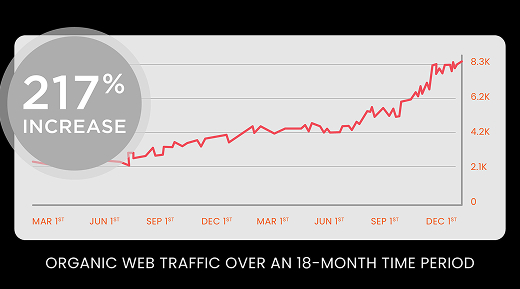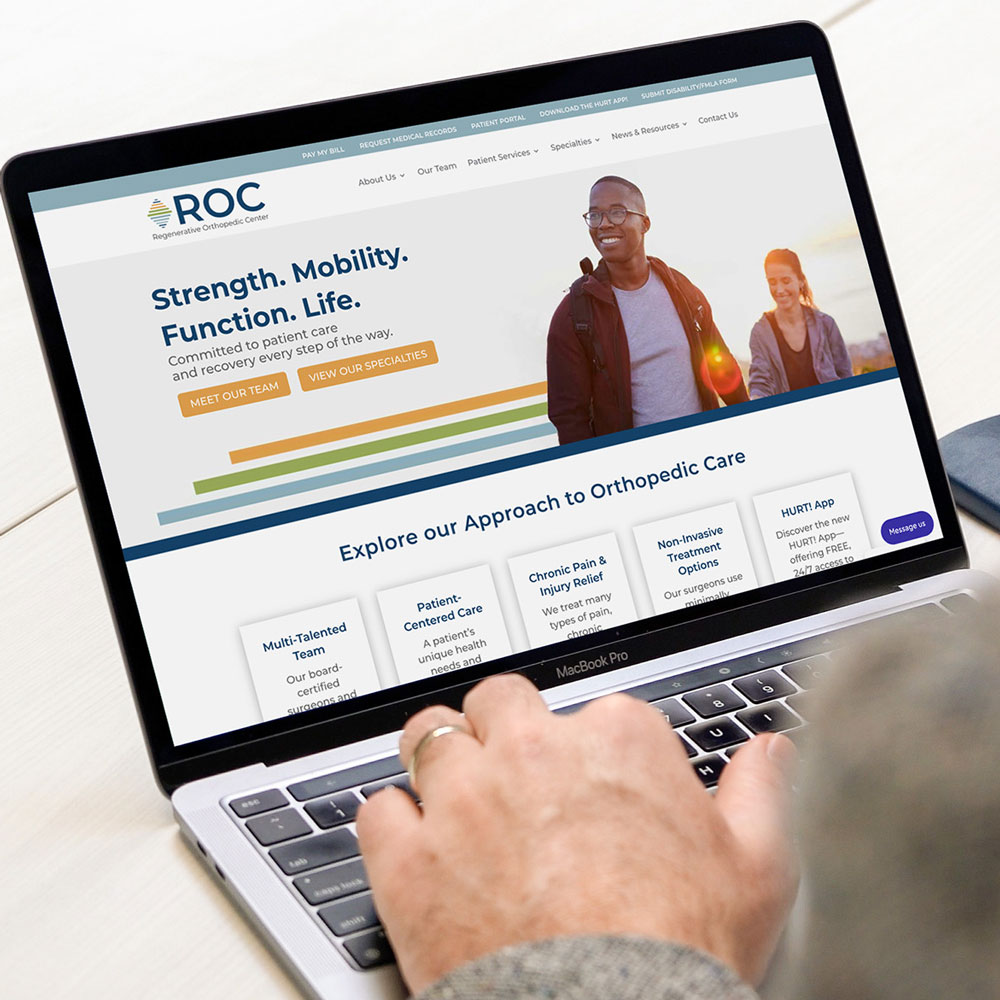Privacy-first marketing refers to strategies that prioritize data protection and HIPAA compliance while still driving patient acquisition and retention. Traditional tactics alone are no longer enough—especially in a landscape where every click, search, and interaction is governed by new regulations and rising patient expectations.

To grow strategically, physician practices and healthcare businesses must adopt an integrated, privacy-first approach—one that meets patients where they are, supports long-term volume goals, and respects their data. This means moving beyond siloed campaigns and embracing a connected strategy that is both effective and compliant.
•High-performance SEO that captures organic traffic for condition-specific, procedure specific, and location-based searches
•Paid digital advertising and social media campaigns that target patients with the right message at the right moment—made possible by our HIPAA-compliant tech stack
•Reputation and listing management that ensures your brand shows up accurately and credibly online—powered by automated review requests and real-time updates
•Traditional and community-based tactics that reinforce your presence offline and build connection authentically, and locally
•Programmatic advertising across Connected TV (CTV), over-the-top (OTT), and display to maximize reach while staying privacy-compliant
A consistent and measurable path that helps patients discover, trust, and choose your practice or healthcare business—without compromising their data or your reputation.
In the sections that follow, we’ll walk through the key components of a privacy-first marketing strategy that drives growth across digital and traditional channels.
How can physician practices attract new patients online? The foundation of attracting patients online is a strong content strategy built for search. Having a website isn’t enough—your audience needs to find you through content that aligns with what they’re searching for.

•Condition-based education: (e.g., knee pain, shoulder arthritis)
•Procedure-specific content: (e.g., joint replacement, urgent ortho care)
•Patient testimonials that build credibility
•Community engagement content: (e.g., local school partnerships)
•FAQ-driven blogs that address specific questions like “When should I consider hip replacement?”
•Self-assessments and tools to help patients understand where they are on their healthcare journey, and take the next step for their recovery
SEO-optimized content—supported by strong meta descriptions, internal links, and localized keywords—isn’t a quick win, but a long-term investment in steady, compounding traffic.
Orthopedic and specialty practices require a layered digital strategy that captures attention at every stage of the patient journey—from awareness to appointment to review.

•Meta (Facebook & Instagram) – for provider updates, awareness, and testimonials
•LinkedIn – for B2B or referral marketing
•TikTok and YouTube – for video education
•Reddit and Pinterest – for condition or lifestyle-specific engagement
•Google & Bing Paid Search – for high-intent queries
•Discovery & PMax – campaigns for automated, cross-platform exposure
•YouTube – ads for long-form brand messaging
These campaigns should lead to mobile-friendly, high-converting landing pages that make it easy to schedule, call, or learn more.
Why is Google Business Profile important for medical practices?
Your Google Business Profile may be your most powerful (and underutilized) acquisition tool. Optimize your profile, including:
•Complete and verified listings across every location and physician
•Regular photo updates and posts about services or physician availability
•Review solicitation systems that follow privacy guidelines but still encourage authentic feedback
A consistent reputation strategy—especially when powered by platforms like SocialClimb—not only boosts your local SEO, it builds trust in competitive specialties like orthopedics and sports medicine.
Does direct mail still work for healthcare marketing?
Absolutely. Traditional marketing still matters—especially in communities where word of mouth and physical presence drive action.
•Postcards targeting people by age, location, or interest can introduce new providers or reinforce your brand
•When integrated with digital campaigns, mail increases awareness and trust, and makes your message more memorable
What is programmatic advertising in healthcare?
Programmatic advertising allows you to reach your audience across premium digital channels with automated, data-driven ad placements that maximize impact—without compromising patient privacy.
What’s the difference between CTV and OTT advertising?
•Connected TV (CTV) lets you deliver ads on streaming platforms such as Hulu, Peacock, and Netflix – where patients are already engaged, offering a compelling way to share provider stories, procedure overviews, and brand positioning.
•OTT (Over-the-Top-Media) extends your reach beyond traditional TV, helping you capture attention in high-viewership environments.
•Display advertising through relevant websites reinforces your message across the web and supports top-of-funnel awareness.
Leveraging these channels ensures your brand stays top of mind—throughout the entire patient decision journey.
securely
securely
Privacy-first marketing in healthcare means designing every marketing tactic—digital or traditional—with patient data protection at the core. It goes beyond general HIPAA regulations to ensure that no electronic protected health information (ePHI) is shared back with third-party platforms that shouldn’t have access to it.
Inherently, no. Google does not sign a Business Associate Agreement (BAA) for paid search advertising, which means any data shared with their platforms—particularly through tracking pixels—is not HIPAA-compliant by default. That includes tools like Google Ads conversion tracking and retargeting, which can inadvertently transmit protected health information (PHI) when users interact with healthcare-related websites.
Removing all pixels might seem like a safe path, but it can leave marketers flying blind. Without attribution data, it’s difficult to measure ROI, optimize campaigns, or prove value across the funnel.
The best approach? Use a privacy-forward customer data platform (CDP) (like FreshPaint) or implement server-side Google Tag Manager. These solutions allow healthcare marketers to maintain visibility while ensuring that no PHI is transmitted to platforms that aren’t HIPAA-compliant—helping you strike the right balance between performance and protection.
Programmatic ads allow you to reach your target audience across digital channels using anonymized data. CTV and OTT platforms let you tell your brand story through video—on Hulu, Roku, and other streaming services—without accessing or storing PHI.
Yes. Postcards, print ads, and community outreach still play a major role—especially in local patient acquisition and brand reinforcement. When integrated with digital efforts, they create a comprehensive, omnichannel experience.
Focus on high-performance SEO, maintain an optimized Google Business Profile, run digital ads using a HIPPA-compliant tech stack, and consistently publish educational content and patient stories that align with your services.
Any part of your technology stack that captures, stores, transmits, or processes electronic protected health information (ePHI) must meet HIPAA requirements. This includes:
Website & Patient Engagement Tools
•Contact forms (especially if they ask about symptoms, appointment types, or provider preferences)
•Online scheduling platforms
•Chatbots or virtual assistants
•Email capture forms (for newsletters, appointment confirmations, etc.)
•Tracking pixels or analytics tools (if tied to patient behavior or identifiable data)
Marketing & CRM Tools
•Customer Relationship Management (CRM) platforms integrated with EHR or patient data
•Marketing automation platforms that send emails or texts using patient information
•Review and reputation tools that collect or display PHI
•Patient acquisition platforms that use targeting based on health status or procedures
Advertising & Analytics
•Retargeting pixels or tags (must not send ePHI back to ad platforms like Facebook or Google)
•Data analytics tools (must be configured to avoid storing or transmitting ePHI unless under a BAA)
Practices can only share de-identified data or aggregated insights with marketing vendors unless a Business Associate Agreement (BAA) is in place.
Without a BAA, you cannot share:
•Names, emails, phone numbers
•Any form of medical condition or treatment info
•Appointment dates
•IP addresses combined with health intent
With a BAA in place, you may share:
•First-party patient data for targeted campaigns
•Email or phone numbers for appointment reminders or follow-ups
•Analytics based on patient journeys or touchpoints
Use these questions to vet a vendor’s understanding of healthcare privacy requirements:
•Do you sign Business Associate Agreements (BAAs)?
•How do you prevent ePHI from being sent to third-party platforms like Facebook or Google?
•What steps do you take to ensure forms, scheduling tools, and tracking pixels are HIPAA-compliant?
•Do you use secure, encrypted methods to store and transmit patient data?
•What experience do you have working with healthcare clients under HIPAA rules?
•How do you handle consent for marketing communications (email, SMS, etc.)?
•Can we review your protocols around HIPAA training and incident reporting?
•Who at your agency is the privacy and/or security officer?
•Can you walk me through how your platform handles first-party data without violating HIPAA?
•How do you audit your compliance practices or verify your tools meet privacy standards?